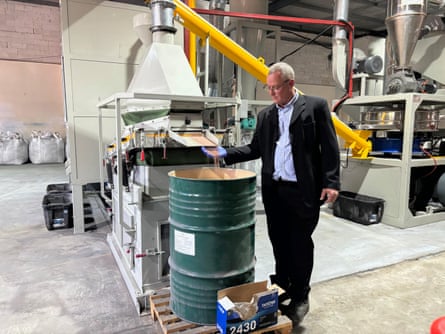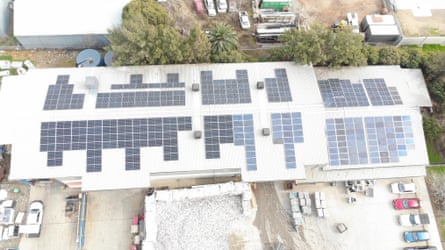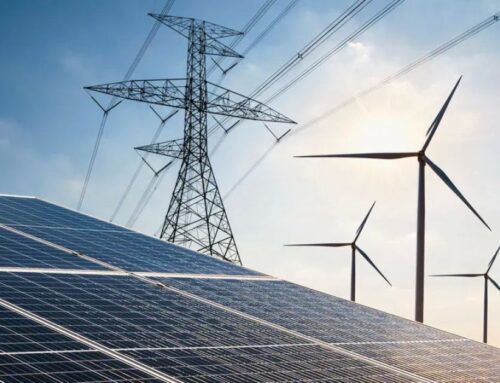Through the roof: how a Brisbane shed is turning old solar panels into silver and copper
October 22, 2024
In a 50m shed south of Brisbane, solar panels are being turned into silver and copper.
Photovoltaic panels no longer capable of producing electricity are having their aluminium and wires removed before being ground up and refined into plastic, glass, silicon, silver and copper. So far, nothing has gone to waste.
The Pan Pacific Recycling director, John Hill, says recovering the materials, with no toxic fumes and nothing going to landfill, is a “big game changer to the whole industry worldwide”.
Currently the company is processing 30,000 panels a year and hopes to scale to 240,000. But the recycling plant’s capacity is a sliver of the 1.2 million solar panels already coming off rooftops in the sunshine state alone.
Recently, Australia’s looming solar waste problem – identified as a priority waste management issue by the federal government back in 2016 – has become larger and more urgent.
Robyn Cowie, stewardship program manager at the Smart Energy Council, says until recently 60% to 70% of the panels coming off rooftops and solar farms in Australia were being sent into overseas reuse markets.
Four weeks ago, demand for Australia’s secondhand solar completely dried up, she says. The price of brand new panels being produced in China is now so cheap that used solar struggles to compete.
“China has an enormous capacity to create panels,” she says. “They’ve got capacity for about 1.2 terawatts of panels. At the moment, they’re utilising about 598 gigawatts of that capacity, and that really is causing the price of panels to come down.”
The rapidly falling cost of new solar – made cheaper in Australia through federal government incentives – is also feeding the solar waste problem, she says. The falling cost encourages households and industry to replace working solar panels early – and the vast majority end up in landfill.
‘Staggering’ landfill
For a range of reasons, solar panels, expected to operate for 20 to 30 years, are being pulled off rooftops and solar farms after 10 or 12 years, well before their time. An inverter fails or a new battery gets installed, triggering a wholesale replacement with new panels capable of generating more electricity from the same roof space.

Early replacements and the closure of secondhand export markets means “extra millions of panels around the nation that are going to need a home, end-of-life”, Cowie says.
While most states are still accepting them in landfill – except Victoria and South Australia, where they are banned – that is “obviously not ideal”, she says.
Associate professor Penelope Crossley, who researches energy law at the University of Sydney, says without a national stewardship scheme there is no incentive to reuse or recycle solar, and sending panels to the tip is often the cheapest option.
Australia is already a world-leader in rooftop solar, installing new systems at 10 times the global rate. There are about 90 million panels on rooftops, she says. “When those solar systems reach end-of-life, current estimates are that 90% of those systems [will] go to landfill.”
Sustainability consultant James McGregor says early retirement is causing a “staggering” number of working solar panels to end up in landfill.
“One in two panels that are ending up in the waste stream at the moment are more than likely fully functional, and still able to give at least 15 years of service life,” he says.
He estimates Australia could throw away eight gigawatts of fully functioning solar panels by 2032 – about a quarter of the currently installed capacity. There will also be faulty panels thrown away that contain critical minerals – such as copper and silver necessary for the renewable energy transition – that could be recovered through recycling.
McGregor’s startup, Second Life Solar, has been working with the New South Wales Environment Protection Authority and the CSIRO to demonstrate the potential for reuse applications, recently completing a 100kW project at a recycling facility in Wagga Wagga, NSW, made up entirely of secondhand panels sent there for recycling.

Reuse is supported by a mobile rapid test rig, developed in collaboration with CSIRO, that tests a solar panel’s electrical and mechanical condition in under 60 seconds – and at a cost of just a few dollars.
McGregor says reusing solar power that would otherwise go to landfill presents an opportunity for local councils and recycling facilities “about to be inundated with waste solar panels” to recover their costs.
“The value of that solar panel might be about $1 in terms of recycling commodities, by the time you process them,” he says. “If I take that exact same 300-watt solar panel and put it out in the sun for a year, it generates $117 with electricity based on average electricity prices.”
The critical material shortage
When solar panels arrive at Pan Pacific’s pilot facility – part of the Smart Energy Council’s solar stewardship program and supported by funding from the Queensland government – they are initially sorted for reuse, before broken and end-of-life panels are recycled.
Hill has found markets for all the recovered materials – the glass, silicon and plastic along with the higher value copper, silver and aluminium – but even taking that into account, recycling still costs Pan Pacific between $10 and $15 a panel.
The Smart Energy Council is calling for a mandatory national stewardship scheme – to maximise reuse and recycling, and to prevent replaced and discarded panels going to landfill.
“We possibly didn’t anticipate the decommissioning to move this fast,” Cowie says. “We think that it’s time for action now.
“It’s not just about ensuring that they don’t end up in landfill. We are going to be facing a critical material shortage in the next 10 to 15 years.”
McGregor says: “It’s also a good opportunity for Australia … At the moment, nearly all of our solar panels are imported from China and at the same time we’re throwing away perfectly good panels … These panels have value and can actually contribute to the net zero target.”
Search
RECENT PRESS RELEASES
Related Post



